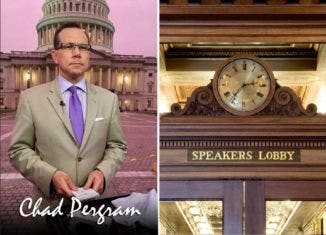Truth or Dare
Schoolchildren dare each other on the playground all the time.
And sometimes lawmakers dare each other on Capitol Hill.
Such was the case Wednesday when the House of Representatives considered two simple, but potentially-radioactive pieces of legislation which were essentially dares. These were instances where House Republicans dared rank-and-file Democrats to vote no.
It’s an election year. And it’s no surprise that there are “dare” votes on the House floor.
The first measure was a bill to freeze the pay of federal workers and lawmakers. The second bill would bar those who receive welfare checks from using that money to purchase alcohol, gamble or pay for strippers.
Who would dare vote against either of those bills?
Plenty. In fact 117 members voted against the pay freeze package and 27 voted against the welfare bill.
That’s not to say that those who argued in favor of both bills didn’t believe in their merits. But a dare is a dare. And Republicans were certainly watching to see who voted against either package.
First, a look at the pay freeze bill.
Just this week, the Congressional Budget Office forecast a deficit of $1.08 trillion for this year. So, it’s only natural that lawmakers want to show that they’re doing their best to hold the bottom line. The much-maligned federal workforce serves as easy pickings. But lawmakers themselves make an even better target. So, they crafted a bill to curb pay hikes for government workers and Members of Congress for the next year.
The House approved the package 309-117. 115 Democrats and two Republicans voted no. Who are those no votes? Mostly lawmakers from safe districts or those who represent districts with a high percentage of federal workers. But you can bet that Republicans were ready to pounce on any potentially vulnerable Democrat who might stray. Holding a vote like this allows the National Republican Campaign Committee (NRCC) to document how someone voted. If they voted “wrong” on the issue, then the NRCC has a vote it can inject into the 2012 election cycle. In a TV spot, a voiceover might mention that Congressman So-and-So voted to hike his own pay. Then fine print would appear at the bottom of the screen supporting the announcer’s claim. It would indicate that the lawmaker in question voted “incorrectly” on HR 3885, during Roll Call Vote 19 on February 1, 2012. In the commercial, voting “improperly” could be portrayed as voting oneself a pay hike.
By the same token, a vote engineered this way gives those who vote “correctly” a chance to congratulate themselves and show their constituents they are not in it for the money. This can help freshman Republicans who hail from swing districts they just flipped into the GOP column in 2010. Such was the case with Rep. Sandy Adams (R-FL) who defeated former Rep. Suzanne Kosmas (D-FL) in the midterm elections.
“As families in Central Florida and across the country are forced to cut back their spending during these tough economic times, why should the federal government be any different?” asked Adams in a news release.
“Schilling Leads by Example, Votes to Freeze Own Pay,” thundered a news release from the office of freshman Rep. Bobby Schilling (R-IL). Schilling knocked off then-Rep. Phil Hare (D-IL) in 2010.
Reps. Roscoe Bartlett (R-MD) and Don Young (R-AK) were the only Republicans to vote no on this bill. But voting nay could be the “right” vote for Bartlett. With Congressional redistricting, Bartlett’s rural district in western Maryland creeps much closer to Washington, DC. It now includes a substantial number of federal employees.
House Minority Whip Steny Hoyer (D-MD) also represents a district just outside Washington. The federal government employs many of his constituents, so he voted no. But Hoyer had particular contempt for the way the GOP structured this piece of legislation.
“If you are voting against the bill, you are voting to raise your own salary,” said Hoyer. “A very good 30-second ad. Isn’t that clever?”
Like Hoyer, Rep. Gerry Connolly (D-VA) represents a sizable federal constituency in his district in the Washington suburbs. Connolly flipped his district from red to blue in 2008. But he eked out an election victory in 2010, winning by slightly less than 1,000 votes. Connolly voted no on Wednesday’s measure. So on its face, Republicans could conceivably target the Virginia Democrat for “voting to raise his own pay.” But Connolly knows he’d be voting against the interests of his district if he voted to freeze the pay of federal employees.
“I consider it a Trojan Horse,” said Connolly. “I’m not going to tie the future of federal employees to our pay.”
The second “dare” vote came on a proposed ban for the use of welfare dollars for adult vices. The House okayed that bill overwhelmingly, 395-27. Rep. Justin Amash (R-MI) was the lone Republican who voted no.
Rep. Karen Bass (D-CA) was one of the 26 Democratic noes. But Bass and many of the other Democrats who voted no represent safe Democratic seats where the GOP has little chance. In her statement after the vote, Bass argued that she didn’t vote “in support of the improper use” of federal welfare dollars. Instead, Bass said that “in rural communities the nearest ATM to withdraw benefits is five miles away at a casino.” She also said that those on welfare in urban areas may only be able to cash their checks at a liquor store.
Here’s another interesting element about these bills: the House considered these measures under a procedure called “suspension of the rules.” By “suspending the usual operating rules, the House requires a two-thirds vote to approve these types of bills. Both pieces of legislation in question Wednesday secured vote totals well above the two-thirds threshold. But had a significant number of Democrats voted no, thus defeating the bill even though the package secured a simple majority of support, Republicans further dared lawmakers to vote yes. Then they could blame those lawmakers for helping defeat the bill.
That said, both the pay freeze and the welfare measures carried wide support.
“Dare” votes are not just the province of Republicans. When Democrats controlled the House, they knew they had enough votes under the regular rules to approve a bill to expand the access of children to health care coverage (known as SCHIP). But, in an effort to “dare” reluctant Republicans to vote against the measure, Democrats trotted the bill out under suspension of the rules. The House defeated the bill, failing to marshal a supermajority of support. Some Republicans from vulnerable districts voted against it. And Democrats prepped ads to run against those lawmakers who voted nay.
There’s another dare afoot in the House this week. Reps. Louise Slaughter (D-NY) and Tim Walz (D-MN) are preparing a “discharge petition” to require the House of Representatives to consider the STOCK Act. That’s a bill which would ban insider trading in Congress. House Majority Leader Eric Cantor (R-VA) says he wants to see if the Senate strengthens the STOCK Act before he’s willing to put the measure on the floor. If the Senate doesn’t bolster the bill to Cantor’s liking, he’ll propose his own plan to prohibit members of a presidential administration from using proprietary information to make trades.
Regardless, Slaughter and Walz want their own version. A discharge petition forces a bill to the floor without the blessing of Congressional leaders. It requires 218 signatures. Slaughter and Walz believe they can easily muster 218 because 271 lawmakers co-sponsored their bill.
There’s been a very vocal, public outcry since 60 Minutes aired a story late last year, suggesting that lawmakers and staff are privy to inside information which help them manipulate their stock portfolios. So, the Slaughter/Walz effort is also a dare of sorts, too.
The Roman poet Virgil said that “fortune sides with him who dares.” And on Capitol those who don’t accept the dares believe that electoral fortune sides with them.

